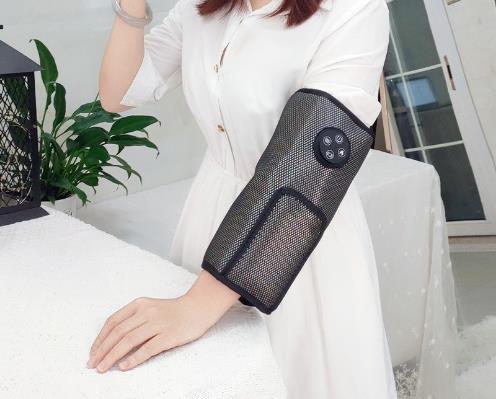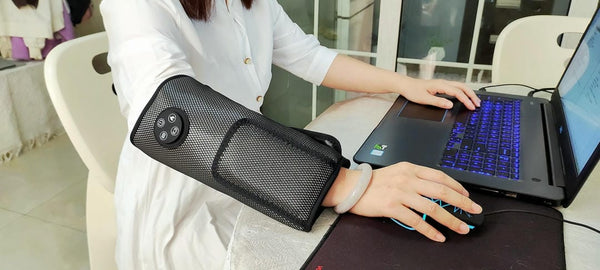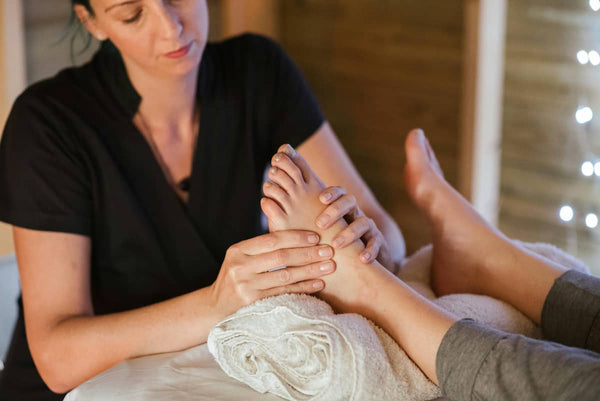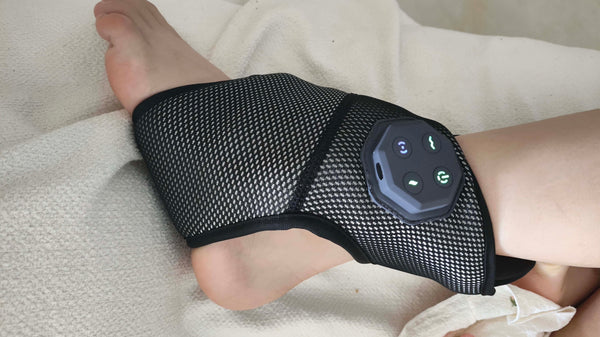 In our increasingly digital world, particularly for office workers, our arms and hands are relentless performers. From typing to mouse-clicking, they bear a significant daily load, often leading to discomfort, tension, and even pain. This brings us to a pertinent question: what exactly is an arm massager, and can it offer genuine relief? The concept isn't new; forms of arm massage have existed for centuries, rooted in traditions that understand the body's intricate network of energy pathways. Today, modern technology seeks to encapsulate these principles into accessible devices. A recent user review of the KLCOSY arm leg Knee Massager sparked an interesting discussion, highlighting both alleviated pain and enhanced flexibility, yet also raising questions about durability and practicality, contrasting with comments on its unique multi-functional features despite low promotion. This really sets the stage for a deeper look.
In our increasingly digital world, particularly for office workers, our arms and hands are relentless performers. From typing to mouse-clicking, they bear a significant daily load, often leading to discomfort, tension, and even pain. This brings us to a pertinent question: what exactly is an arm massager, and can it offer genuine relief? The concept isn't new; forms of arm massage have existed for centuries, rooted in traditions that understand the body's intricate network of energy pathways. Today, modern technology seeks to encapsulate these principles into accessible devices. A recent user review of the KLCOSY arm leg Knee Massager sparked an interesting discussion, highlighting both alleviated pain and enhanced flexibility, yet also raising questions about durability and practicality, contrasting with comments on its unique multi-functional features despite low promotion. This really sets the stage for a deeper look.
This exploration will delve into the world of the arm massager, considering its foundations, the mechanisms by which it works, and its potential benefits, especially for those spending long hours at a desk. We'll also touch upon what to look for, drawing insights from user experiences like those with the KLCOSY model. My journey in physiotherapy has always been about bridging ancient wisdom with contemporary solutions to promote well-being, and these devices are a fascinating example of that synthesis.
What is an Arm Massager?
At its core, an arm massager is a device designed to apply therapeutic pressure, movement, or other stimuli to the muscles and tissues of the arm, from the shoulder down to the wrist and hand. The fundamental purpose is to alleviate discomfort, reduce muscle tension, improve circulation, and promote relaxation. From a traditional perspective, such massage aims to ensure the smooth flow of Qi (vital energy) through the meridians, or energy channels, that traverse the arms. Blockages or imbalances in this flow are often considered contributors to pain and stiffness. Modern devices, from simple manual tools to sophisticated electronic units, aim to replicate these effects.
These massagers come in various forms. Some are manual, requiring self-application of pressure, while many modern versions are electric, utilizing air compression, vibration, heat, or rollers. You might encounter them as sleeves that encompass the entire arm, smaller units focusing on the forearm or hand, or even as versatile arm wraps that can be adjusted for targeted relief. The KLCOSY device mentioned in reviews, for instance, points towards a multi-purpose design, capable of addressing not just arms but also legs, suggesting a trend towards integrated wellness tools. While a dedicated arm massager focuses on the upper limbs, some, like certain leg calf massager units, might have attachments or designs that can be adapted, albeit perhaps less effectively, for arm use too.
- Manual Massagers: Tools like rollers or pressure point applicators.
- Electric Massagers: Employing mechanisms like vibration, air compression, or heat.
- Sleeve Designs: Covering larger portions of the arm for comprehensive massage.
- Targeted Units: Focusing on specific areas like forearms, elbows, or hands.
- Multi-Functional Devices: Designed for use on multiple body parts, including arms.
The Evolution from Ancient Practice to Modern Device
The practice of massaging limbs for relief and well-being isn't a recent invention. Ancient healing traditions across various cultures, including Chinese medicine, have long recognized the benefits of manipulating soft tissues to alleviate pain and restore balance. These practices often involved intricate knowledge of acupressure points and energy meridians in the arms, believing that stimulating these areas could influence not just local comfort but overall health. The principles were simple: encourage circulation, release tension, and facilitate the body's natural healing capabilities.
Modern arm massager devices, including those like the KLCOSY, build upon this ancient foundation. While they employ technology like microprocessors and pneumatic pumps, the underlying goal often mirrors traditional objectives. For example, sequential air compression can mimic the "pushing" (Tui Na) techniques used to move Qi and blood. The development of such devices reflects a desire to make these therapeutic benefits more accessible and convenient for daily use, especially in a fast-paced world where finding time for a manual therapy session can be challenging. It's an evolution, not a replacement, of time-honored principles.
The journey has seen a shift from purely manual techniques to these mechanical and electronic aids. User feedback, like the discussions around the KLCOSY model's unique features versus its perceived lower market presence, shows an active engagement with this evolution. People are looking for effective, easy-to-use solutions, and the market is responding with increasingly sophisticated, albeit sometimes variably durable, options. This is a common theme in many arm massage reviews.
The Core Principles: Balancing Energy and Easing Tension
From both a traditional and modern physiological standpoint, the effectiveness of an arm massager hinges on its ability to restore balance and ease tension. In traditional Chinese medicine, the arms are crisscrossed by several important meridians connected to various organs. Repetitive strain, stress, or injury can disrupt the flow of Qi and blood along these pathways, leading to stagnation, which manifests as pain, numbness, or weakness – common complaints for office workers dealing with issues like potential tennis elbow precursors.
Modern science explains these benefits through mechanisms like increased blood flow, which delivers more oxygen and nutrients to tissues while helping to flush out metabolic waste products. Massage can also stimulate mechanoreceptors in the skin and muscles, leading to a relaxation response and a reduction in the perception of pain. An effective arm massager, therefore, works by promoting this physiological balance, helping to release constricted muscle fibers, soothe irritated nerves, and improve overall tissue health. The aim is to bring the arm back to a state of ease and functional harmony.
- Qi and Blood Circulation: Enhancing flow through meridian pathways.
- Muscle Relaxation: Releasing knots and hypertonic (tight) muscles.
- Nerve Decompression: Alleviating pressure on nerves that can cause pain or numbness.
- Waste Product Removal: Assisting lymphatic drainage and removal of metabolic byproducts.
- Stress Reduction: The soothing action can have a calming effect on the nervous system.
What Techniques Can an Arm Massager Employ?
 Modern arm massagers utilize a variety of techniques, often aiming to simulate the hands of a skilled therapist. One of the most common is air compression, where airbags within the device inflate and deflate sequentially or in zones, providing a squeezing massage. This is excellent for promoting circulation and a general sense of relief. Some devices incorporate vibration massage, which can help to relax superficial muscles and stimulate nerves. Heat therapy is another popular feature, which can significantly enhance muscle relaxation and prepare tissues for deeper massage, making the experience more effective, particularly for chronic tension.
Modern arm massagers utilize a variety of techniques, often aiming to simulate the hands of a skilled therapist. One of the most common is air compression, where airbags within the device inflate and deflate sequentially or in zones, providing a squeezing massage. This is excellent for promoting circulation and a general sense of relief. Some devices incorporate vibration massage, which can help to relax superficial muscles and stimulate nerves. Heat therapy is another popular feature, which can significantly enhance muscle relaxation and prepare tissues for deeper massage, making the experience more effective, particularly for chronic tension.
More advanced units, perhaps like the KLCOSY with its touted multi-functionality and combinable massage, might offer several of these simultaneously or in pre-programmed sequences. Adjustable intensity is a crucial aspect noted in the KLCOSY's advantages; this allows users to customize the massage from a gentle touch to a more vigorous action, depending on their needs and tolerance. The idea of "combinable massage" suggests an intelligent integration of these techniques, potentially offering a more holistic and effective treatment than a single-mode device. This ability to tailor the experience is often a key factor when searching for the best arm massager for pain.
Other techniques can include kneading, using nodes or rollers to mimic the thumbs and fingers, or even targeted acupressure. The specific combination of these features in an arm massager will determine its overall feel and therapeutic focus. For office workers, features that address forearm tightness, wrist discomfort, and even elbow pain (like that associated with tennis elbow) are particularly valuable.
The Benefits: More Than Just a Pleasant Sensation
The advantages of using an arm massager extend far beyond a fleeting moment of comfort, directly addressing issues many office workers face. The KLCOSY user's report of alleviated arm, leg, and knee pain, along with enhanced flexibility, underscores these tangible outcomes. Regular use can lead to significant pain relief, especially for those suffering from repetitive strain injuries (RSIs), carpal tunnel-like symptoms, or general muscle fatigue from prolonged computer use. Improved circulation is another key benefit, vital for tissue repair and reducing feelings of heaviness or numbness in the arms.
Moreover, consistent arm massage can help reduce muscle stiffness and improve range of motion, making daily tasks more comfortable. For those developing conditions like tennis elbow from repetitive tasks, an arm massager focusing on forearm muscles can be a valuable supportive tool. Stress reduction is also a significant, though sometimes overlooked, benefit. The rhythmic, soothing action can calm the nervous system, contributing to overall well-being. Many positive arm massage reviews frequently highlight these improvements in daily comfort and function as primary reasons for satisfaction.
- Pain Alleviation: Reducing discomfort from RSIs, muscle strain, and conditions like tennis elbow.
- Improved Circulation: Enhancing blood flow to nourish tissues and remove waste.
- Reduced Muscle Stiffness: Increasing flexibility and range of motion.
- Stress Relief: Promoting relaxation and calming the nervous system.
- Support for Injury Recovery: Assisting in the healing process when used appropriately.
What Conditions Can an Arm Massager Help With?
An arm massager can be beneficial for a range of conditions commonly experienced by office workers and others who use their arms intensively. Repetitive Strain Injuries (RSIs) are a prime example, where overuse leads to inflammation and pain in muscles, tendons, and nerves of the forearm, wrist, and hand. Symptoms leading up to carpal tunnel syndrome, such as tingling or numbness, may also be eased by improved circulation and reduced pressure on the median nerve facilitated by regular massage. General muscle fatigue and soreness from hours of typing or mousing are also effectively addressed.
For those experiencing the specific pain of tennis elbow (lateral epicondylitis) or golfer's elbow (medial epicondylitis), targeted massage to the forearm extensor or flexor muscles can provide relief by reducing tension in the affected tendons. While an arm massager is primarily for the upper limbs, multi-functional devices like the KLCOSY, which also function as a leg calf massager or knee massager, offer broader utility. However, for arm-specific issues, finding the best arm massager for pain related to these conditions is paramount. While specific studies on all devices are not always available, the principles of massage therapy are well-established for these types of musculoskeletal complaints.
It's important to remember that while an arm massager can provide significant relief, it's not a cure-all. For persistent or severe pain, consulting a healthcare professional is always recommended to rule out more serious conditions and get a proper diagnosis. Think of it as a valuable part of your self-care toolkit.
What to Expect: From Unboxing to Regular Use
When you invest in an arm massager, the initial experience usually involves unboxing and familiarizing yourself with the device and its controls. Most modern units, even those with multiple functions like the KLCOSY, are designed for ease of use. You'll typically find adjustable straps for arm wraps or sleeves to ensure a snug fit, a control panel for selecting modes and intensity, and perhaps a power adapter or rechargeable battery. The user reporting on the KLCOSY mentioned its safety and ease of use as advantages, which is a critical factor for any home-use therapeutic device.
However, the same user also raised questions about durability and practicality for daily use. This is a valid concern. The longevity of an arm massager can depend on its build quality, the frequency of use, and how well it's maintained. Practicality for daily use involves how easily it can be incorporated into your routine – is it quick to set up? Is it comfortable for the duration of a session? These are important considerations beyond just the immediate massage sensation. Reading various arm massage reviews can often provide insights into these longer-term aspects. While specific data on the KLCOSY's durability isn't broadly available, this user's perspective highlights a common checkpoint for potential buyers.
Regular use might involve 15-30 minute sessions, perhaps daily or a few times a week, depending on your needs. You should start to notice benefits like reduced tension or pain over time, but consistency is often key. It's not just about that one-off good feeling; it's about cumulative benefits.
In conclusion, an arm massager can be a highly beneficial tool, particularly for office workers grappling with the physical tolls of a desk-bound job. By blending principles rooted in ancient therapeutic practices with modern technological advancements, these devices offer a convenient way to alleviate pain, reduce muscle tension, improve circulation, and promote relaxation in the arms. The KLCOSY example, with its mix of positive outcomes like pain relief and unique features against concerns of durability and low promotion, encapsulates the current landscape: promising technology that still requires careful consideration by the user.
From my perspective, focusing on how these tools can support the body's natural balance and energy flow is key. An arm massager that is multi-functional, offers adjustable intensity, and is easy to integrate into daily life—much like the described advantages of the KLCOSY series—holds significant promise. While no device is a panacea, a well-chosen arm massager can certainly be a valuable ally in maintaining arm health and overall well-being in our modern, demanding lifestyles. Seeking out comprehensive arm massage reviews and understanding your own needs will guide you to the best arm massager for pain relief and daily comfort.
Frequently Asked Questions (FAQ)
Can you massage your arm for relief?
Absolutely! Massaging your arm can provide significant relief from various types of discomfort, including muscle soreness, stiffness, tension, and pain. Whether done manually or with an arm massager, the process helps to increase blood flow to the area, delivering more oxygen and nutrients to the tissues while helping to flush out metabolic waste products. This can reduce inflammation, relax tight muscles, and soothe irritated nerves. For office workers or anyone performing repetitive arm movements, regular arm massage can be a very effective way to alleviate accumulated stress and prevent more chronic issues.
Does arm massage help joint pain?
Yes, arm massage can be beneficial for certain types of joint pain, particularly if the pain is related to muscle tightness or inflammation in the tissues surrounding the joint (like in cases of tennis elbow or golfer's elbow). By relaxing the muscles that attach near the joints and improving circulation to the area, an arm massager can help reduce stress on the joint itself. This can alleviate pain and improve mobility. However, if joint pain is severe, persistent, or due to conditions like arthritis, it's crucial to consult a healthcare professional for diagnosis and appropriate treatment. Massage can be a helpful complementary therapy in many cases.
Are arm massagers multi-functional like KLCOSY?
Many modern arm massagers are indeed designed with multi-functionality in mind, similar to the KLCOSY model described. This can include features like different massage modes (e.g., compression, vibration, heat), adjustable intensity levels, and sometimes even the ability to be used on other body parts like legs or knees (making them a versatile leg calf massager too). The KLCOSY, as noted by a user, stands out for advantages such as multi-functionality, combinable massage options, and being a multi-purpose machine. This trend reflects a consumer desire for comprehensive wellness tools that offer a range of therapeutic benefits from a single device, providing greater value and convenience.
This reply is generated based on currently verifiable public information. It is recommended to cross-check key content with authoritative sources.




0 comments